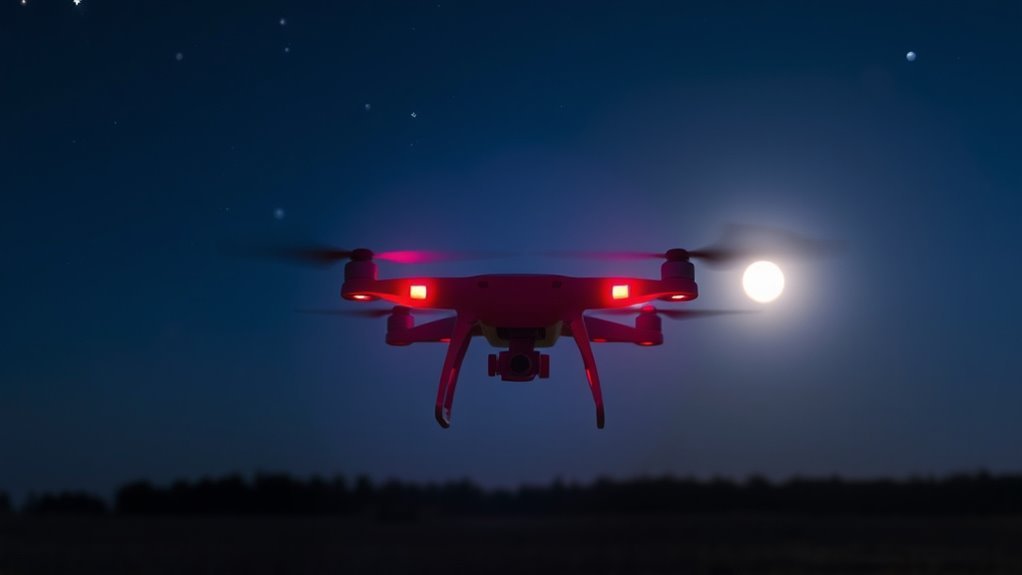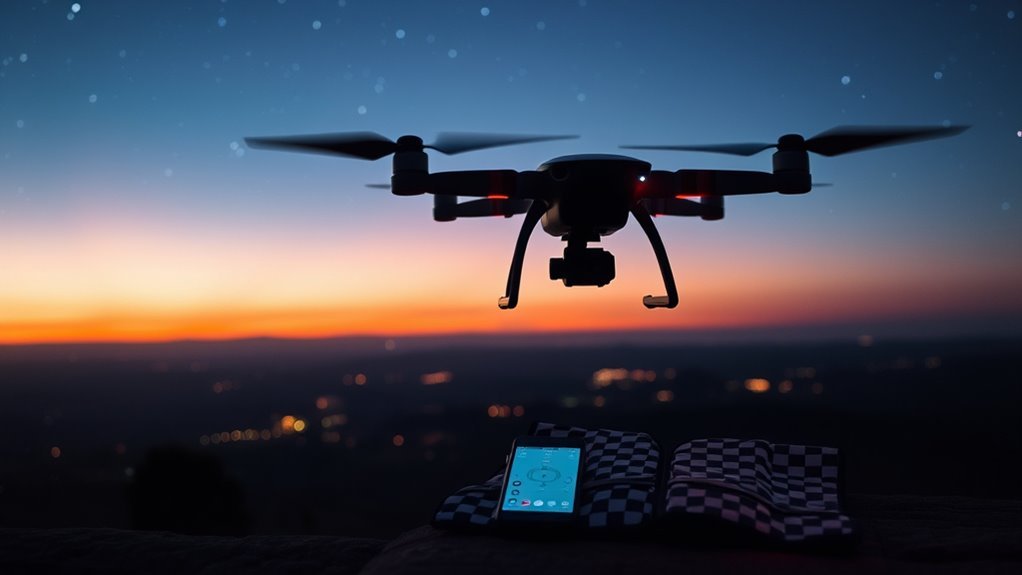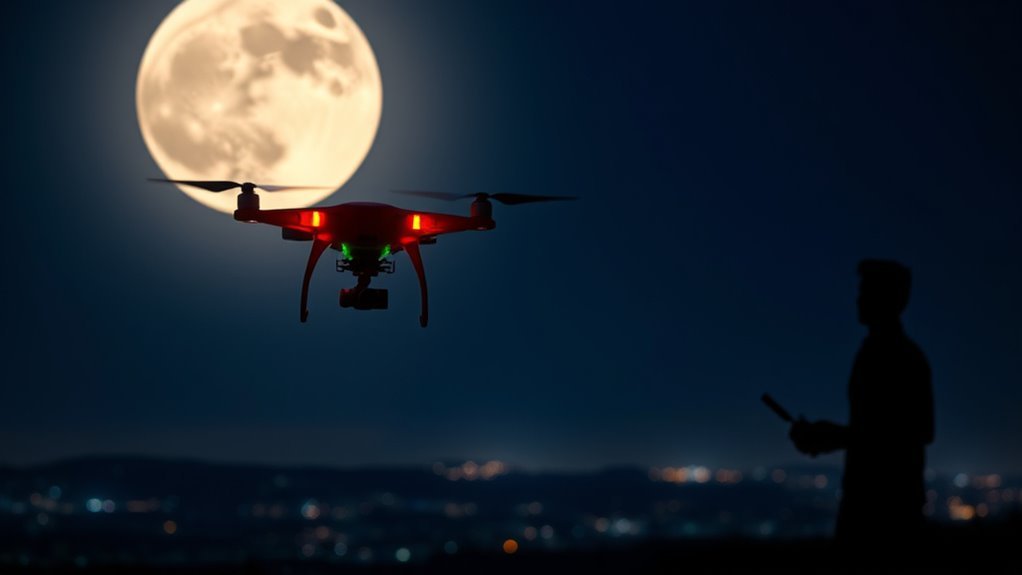To fly drones at night, you need to follow FAA regulations, including using proper lighting for visibility and maintaining a clear line of sight. A Part 107 Remote Pilot Certificate is mandatory, and your drone must have lights visible from at least three statute miles. Additionally, check for any local laws or restrictions in your area to guarantee compliance. Understanding these requirements is essential for legal nighttime operations, and more insights await you.
Understanding the FAA Regulations for Nighttime Drone Operations

When you consider flying drones at night, it’s crucial to understand the FAA regulations that govern these operations. Nighttime flying isn’t just about the thrill; it involves precise adherence to safety standards. You must guarantee your drone is equipped with proper lighting to maintain flight visibility during low-light conditions. The FAA mandates that you have the ability to see your drone at all times, which often requires night vision aids or enhanced lighting systems. Additionally, you need to hold a Part 107 Remote Pilot Certificate, even at night. Failing to comply with these regulations can lead to penalties and jeopardize your freedom to fly. Knowledge of these rules is essential for a responsible and enjoyable nighttime drone experience.
Equipment Requirements for Night Flying

To guarantee safe and compliant nighttime drone operations, equipping your drone with the right gear is essential. First, consider installing night vision technology to enhance your ability to navigate and control your drone in low-light conditions. This equipment allows you to identify obstacles and maintain visual line-of-sight, complying with FAA regulations. Additionally, make certain your drone meets the illumination requirements; it must have lights that are visible from a minimum distance of three statute miles. These lights not only help you see but also make your drone detectable to others, promoting safety. Finally, consider using reflective tape or markers to further improve visibility. Investing in the right equipment not only enhances your flying experience but also keeps you within the bounds of the law.
Pre-Flight Checklist for Nighttime Flights

Before you launch your drone for a nighttime flight, it is crucial to conduct a thorough pre-flight checklist to guarantee safety and compliance. Start by ensuring your night vision equipment is functioning correctly, as this will greatly enhance your situational awareness in low-light conditions. Check your drone’s battery life; flying at night can drain batteries faster due to additional lighting requirements. Also, review your flight area for potential obstacles and confirm you have the necessary permissions.
| Task | Status |
|---|---|
| Night vision check | [ ] Complete |
| Battery life check | [ ] Complete |
| Obstacle assessment | [ ] Complete |
| Flight area permissions | [ ] Complete |
| Emergency plan ready | [ ] Complete |
With this checklist, you can embrace the freedom of night flying responsibly.
Best Practices for Safe Night Operations
While flying drones at night can be exhilarating, adhering to best practices is essential for guaranteeing safety and compliance. First, invest in quality night vision equipment to enhance your ability to see and navigate effectively. This will allow you to identify obstacles and maintain situational awareness. Next, make sure your drone is equipped with robust lighting systems, as they not only improve visibility but also make your drone more recognizable to others. Maintain a clear line of sight, as this is critical during nighttime operations. Finally, regularly monitor battery levels, as lower light conditions can drain power faster. By implementing these practices, you’ll enjoy the freedom of night flying while prioritizing safety and compliance.
Navigating Local Laws and Restrictions
Understanding and maneuvering through local laws and restrictions is vital for any drone operator, especially when flying at night. Each region has its own local regulations that dictate where and when you can operate your drone after dark. Before taking off, check for any nighttime restrictions that may apply to your area, such as no-fly zones or specific curfews. It’s important to stay informed about these rules, as they can vary considerably between municipalities and even neighborhoods. Ignoring local laws can lead to fines or worse. By respecting these regulations, you not only safeguard your freedom to fly but also contribute to the safety and acceptance of drone use within your community. Stay informed, and you’ll enjoy your nighttime flights responsibly.
Frequently Asked Questions
Can I Fly My Drone Over Populated Areas at Night?
You can’t fly your drone over populated areas at night without adhering to specific nighttime regulations. Urban flying demands strict compliance to guarantee safety and legality, so always check local laws and guidelines before taking off.
Do I Need a Special License for Night Flights?
“Where there’s a will, there’s a way.” For night flights, you typically need a specific license. Adhering to night flight regulations and drone safety guidelines is essential to guarantee compliance and safety during your operations.
How Do I Know if My Drone Is Night-Legal?
To determine if your drone’s night-legal, check compliance with night flight regulations and guarantee it meets drone light requirements. Proper lighting is essential for visibility, safety, and adherence to FAA standards during nighttime operations.
What Are the Penalties for Violating Nighttime Drone Rules?
Imagine soaring through a starlit sky; however, if you breach nighttime drone regulations, you risk hefty fines and potential legal consequences. A penalties overview reveals that freedom’s tether can quickly turn into a heavy chain.
Are There Insurance Requirements for Night Drone Flying?
When considering night flying, you should check if your drone insurance covers nighttime operations. Many policies require specific coverage for night flying, ensuring you’re protected against potential liabilities and damages during your aerial adventures.

